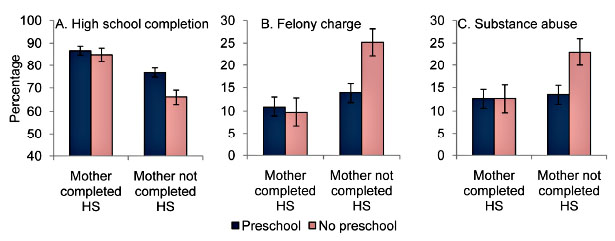Dana Goldstein says that if she could have her pick of one big idea to inject into the presidential campaign, it would be universal pre-K schooling:
Any radical rethinking of American public policy ought to start with a consideration of one of our most politically neglected populations: The majority of 3-to-5-year-olds who have no access to high-quality, low-cost educational options. As scientists have learned more about the brain, they’ve concluded the early years are the most crucial ones for cognitive development. Seventy-five percent of middle-class kindergarteners can write their own names, compared to just about half of poor kindergartners. The typical middle-class 5-year old can identify all 26 letters of the alphabet on her first day of school; a 5-year old living in poverty may know only two letters. By first grade, middle-class children have double the vocabulary of their low-income peers.
Regular readers know that I’m on board with this. In fact, aside from universal healthcare, it’s about the only big-ticket social program that I’m completely sold on. My reasons, however, are a little different than Dana’s. Universal pre-K might very well raise academic achievement, but frankly, the evidence on that score is fairly thin. Nonetheless, there are good reasons to support universal pre-K anyway.
We all know that nothing is certain except death and taxes, but with that caveat out of the way I think we can safely say that there’s a pretty compelling body of evidence that pre-K has a ton of benefits. It might raise IQs and jumpstart academic achievement — and certainly won’t do any harm — but that’s the least of its effects. A growing body of research suggests that pre-K increases high school completion rates; reduces rates of substance abuse; reduces felony rates; increases lifetime income; and improves non-IQ cognitive traits like the ability to delay gratification, the ability to hold a job, and the ability to control your temper. What’s more, there’s a growing body of evidence that especially bad home environments cause permanent biological damage and can do it before the age of two.

So it’s not just pre-K. It’s also things like home nursing visits and better childcare in our poorest neighborhoods. And it wouldn’t be cheap. But as near as I can tell, taking, say, $100 billion out of K-12 education and redirecting it to pre-K would almost certainly be a pure win. That might not be the best way to fund it, but if political realities prevent us from raising more money in the near future, shifting spending would be a second-best alternative. Given the almost endless procession of educational reforms that turn out to have no measurable effect once you scale them up or study them for more than a couple of years, I doubt that decreasing funding for K-12 would have anywhere near as big an effect as increasing funding for pre-K. There are too many interest groups dedicated to K-12 funding to make this kind of funding shift easy, but it’s something worth pushing for anyway.

















